
The geography of Israel is very diverse, with desert conditions in the south, and snow-capped mountains in the north. Israel is located at the eastern end of the Mediterranean Sea in West Asia. It is bounded to the north by Lebanon, the northeast by Syria, the east by Jordan and the West Bank, and to the southwest by Egypt. To the west of Israel is the Mediterranean Sea, which makes up the majority of Israel's 273 km (170 mi) coastline, and the Gaza Strip. Israel has a small coastline on the Red Sea in the south.

The demographics of Israel, monitored by the Israel Central Bureau of Statistics, encompass various attributes that define the nation's populace. Since its establishment in 1948, Israel has witnessed significant changes in its demographics. Formed as a homeland for the Jewish people, Israel has attracted Jewish immigrants from Europe, Asia, Africa, and the Americas.

Gaza, also called Gaza City, is a Palestinian city in the Gaza Strip. Prior to the 2023 Israel–Hamas war, it was the most populous city in the State of Palestine, with 590,481 inhabitants in 2017.
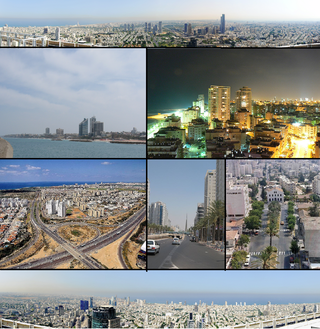
Gush Dan or Tel Aviv metropolitan area is a conurbation in Israel, located along the country's Mediterranean coastline. There is no single formal definition of Gush Dan, though the term is in frequent use by both governmental bodies and the general public. It ranges from combining Tel Aviv with cities that form an urban continuum with it, to the entire areas from both the Tel Aviv District and the Central District, or sometimes the whole Metropolitan Area of Tel Aviv, which includes a small part of the Southern District as well. Gush Dan is the largest conurbation and metropolitan area in Israel, with the metropolitan area having an estimated population of 4,156,900 residents, 89% of whom are Israeli Jews.
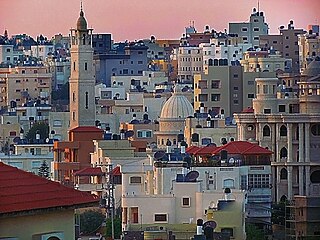
Tayibe, also spelled Taibeh or Tayiba, is an Arab city in central Israel, 12 km (7 mi) north east of Kfar Saba. Part of the Triangle region, in 2022 it had a population of 46,020. Its citizens are Muslims and Christians.

The Northern District is one of Israel's six administrative districts. The Northern District has a land area of 3,324 km2, making it the second largest district in Israel. The district capital is Nof HaGalil and the largest city is Nazareth.
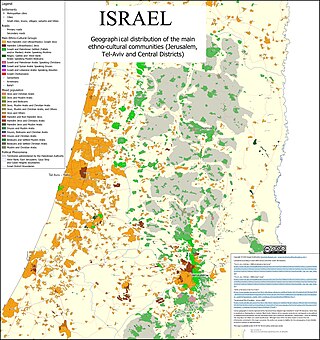
The Tel Aviv District is the geographically smallest yet also the most densely populated of the six administrative districts of Israel, with a population of 1.35 million residents. It is 98.9% Jewish and 1.10% Arab.

The Jerusalem District is one of the six administrative districts of Israel. The district capital is Jerusalem. The Jerusalem District has a land area of 652 km2. The population of 1,159,900 is 66.3% Jewish and 32.1% Arab. A fifth (21%) of the Arabs in Israel live in the Jerusalem Municipality, which includes both East and West Jerusalem. Israel's annexation of East Jerusalem has not been recognized by the international community.

Tulkarm or Tulkarem is a Palestinian city in the West Bank, the capital of the Tulkarm Governorate of the State of Palestine. The Israeli city of Netanya is to the west, and the Palestinian cities of Nablus and Jenin to the east. According to the Palestinian Central Bureau of Statistics, in 2017 Tulkarm had a population of 64,532. Tulkarm is under the administration of the Palestinian National Authority.

Arab diaspora is a term that refers to descendants of the Arab emigrants who, voluntarily or as forcibly, migrated from their native lands to non-Arab countries, primarily in the Americas, Europe, Southeast Asia, and West Africa.
Shaghur or Shagor was an Arab city in the Northern District of Israel located east of the coastal city of Acre (Akka). It was formed in 2003 with the merger of three Arab local councils – Majd al-Krum, Deir al-Asad and Bi'ina. It was declared a city in 2005. The city was dissolved on December 1, 2008 by Knesset decree and the pre-2003 component villages were given independent standing. It is the third largest Arab locality in the Northern District after Nazareth and Shefa-'Amr. The name Shaghur comes from the name of the nearby valley which borders the al-Araas mountain in which the city is built upon. The city had a population of 29,900 at the end of 2007.
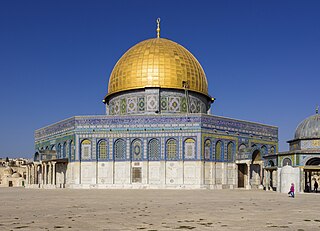
As of 2022, Muslims are the largest religious minority in Israel, accounting for 18.1% of the country's total population. Most of this figure is represented by the Arab citizens of Israel, who are the country's largest ethnic minority, but there is a notable non-Arab Muslim populace, such as that of the Circassians. Upwards of 99% of Israel's Muslims are Sunnis and the remainder are Ahmadis. Despite Shias constituting the second-largest Islamic sect, there are no reliable sources attesting a Shia presence in Israel or the Israeli-occupied West Bank, which the Israeli government administers as the Judea and Samaria Area. There were only seven Shia villages in the entirety of Mandatory Palestine and all of these were located along what is now the Israel–Lebanon border before being depopulated during the 1948 Arab–Israeli War.

Kafr 'Aqab is the northernmost Palestinian Arab neighborhood in East Jerusalem. It is part of the area annexed and included in municipal Jerusalem following its occupation by Israel in 1967. This area includes an additional approximate 64 km2 (25 sq mi) of the West Bank, including territory which previously included 28 villages and areas of the Bethlehem and Beit Jala municipalities. Although the Jerusalem Law did not use the term, the Israeli Supreme Court interpreted the law as an effective annexation of East Jerusalem. The United Nations Security Council condemned the attempted change in status to Jerusalem and ruled the law "null and void" in United Nations Security Council Resolution 478.

In Israel, the Jerusalem metropolitan area is the area encompassing the approximately one hundred square miles surrounding the Old City of Jerusalem with a population of 1,253,900. The expansion of Jerusalem under Israeli law followed its official annexation of the city in the aftermath of the 1967 Six-Day War. Greater Jerusalem is divided into three areas: the outer ring, the New City/Center, and The Historical Center/Inner Ring. The rings are mainly used as an administrative tool to incorporate, public transit, housing, and utility services under a common structure. Greater Jerusalem can be said to encompass the entire City of Jerusalem and its suburbs. It is the second largest metropolitan area in Israel, behind Gush Dan.

The Haifa metropolitan area is a metropolitan area including areas from both the Haifa and the Northern districts of Israel. It is located along the Israeli Mediterranean coastline. With an estimated population of almost 1 million, the Haifa metropolitan area is the third largest metropolitan area in Israel, behind Gush Dan and Greater Jerusalem.

Beersheba metropolitan area is a metropolitan area in Israel that encompasses the Beersheba and Southern Districts of Israel. It is located in the Negev desert and constitutes the fourth largest metropolitan area in the country, with an estimated population of over 377,100.
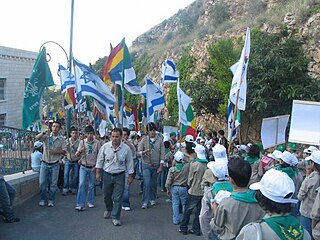
Israeli Druze or Druze Israelis are an ethnoreligious minority among the Arab citizens of Israel.

The Palestinian diaspora, part of the wider Arab diaspora, are Palestinian people living outside the region of Palestine.















